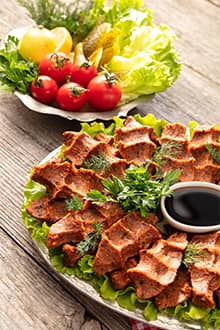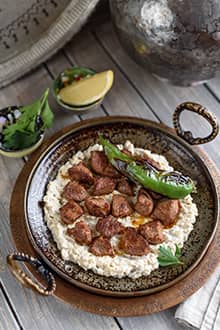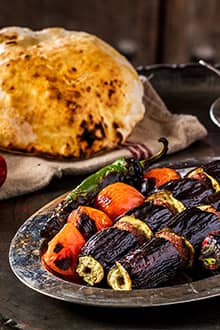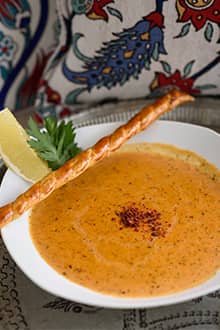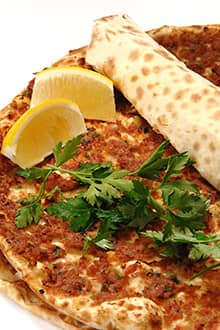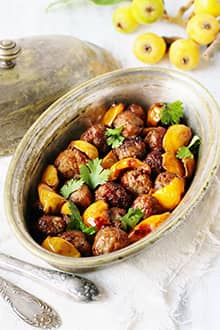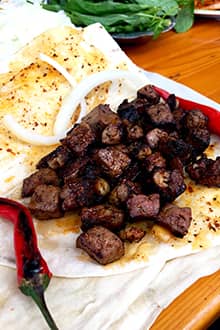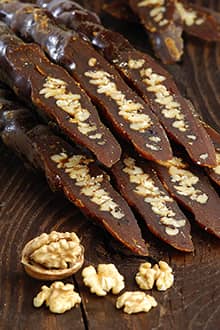

taste
Mesopotamia Türkiye
The development of agriculture can be described as the first revolution in the history of humanity and it was accomplished approximately 10,000-12,000 years ago in the territories of Mesopotamia. Wheat, which is the symbol of the transition to sedentary life and the symbol of agriculture, has an important position in the region’s cuisine.
Unique Wheats
Durum wheat (Triticum durum) was first cultivated in the Karacadağ region that is located on the border between Şanlıurfa and Diyarbakır, and from here it spread all around the world.
It is still possible to see Siyez wheat (Einkorn wheat) that is the wild ancestor of wheat in the Karacadağ region. This is a geography where chickpeas were also cultivated, and the consumption of chickpeas is also high in the region. For example, breakfast in the Birecik district of Şanlurfa province consists of a chickpea wrap that is prepared by wrapping chickpeas baked in the oven in a thin flatbread and adding chili pepper, black pepper, and salt.
Wood-Fired Cooking
Wood-fired ovens are widely popular in Şanlıurfa, Gaziantep, Adıyaman, and Diyarbakır, and are a modern-day reflection of the wheat culture of 12,000 years ago. Many dishes are still cooked in wood-fired ovens in these provinces and they are accompanied by wheat products such as flatbread, crackers, and rusk. The regional word for bread remains the same since the time of the Sumerians: nan.
Delicacies of the Fertile Crescent
The productive soils of the Fertile Crescent were kneaded with the various cultures hosted on these lands over thousands of years. The local food culture is like a guide that allows us to follow the traces of these different cultures.
The list of special flavors born here is very long: Antep baklava, Antep fıstığı (pistachio), Diyarbakır watermelon, Diyarbakır plaited cheese, Mardin ikbebet, Mardin imlebes, Mardin kaburga dolması, Mardin kibe, Mardin sembusek, Nizip olive oil (Gaziantep), Siirt Pervari honey, Siirt büryan kebab, Siirt perde pilavı, Şanlıurfa pepper, Şanlıurfa çiğ köfte. Furthermore, depending on the season herbs such as tuzik and thistle are cultivated and widely consumed.
Gaziantep plays an important role with its registered 391 regional foods such as baklava, kebab, and lahmacun. Gaziantep is among the distinguished cities which became popular with their regional cuisines and is one of the Türkiye’s culinary centers.
The Emine Göğüş Culinary Museum was established in 2008 in Gaziantep and is Türkiye’s first culinary museum. At the museum you can learn about the regional culinary culture and attend cooking classes.
A Very Special Dish: Kebab
Kebab is the first food that comes to mind when one thinks of the Fertile Crescent. Kebab, which is popular across Türkiye – and the world - is prepared by marinating meat and spices and grilling the meat over charcoal.
Fruits and vegetables are cooked alongside meat to create mouthwatering kebabs, stews, and a variety of stuffed dishes. Kemeli Tike kebab, Yenidünya kebab, eggplant kebab, kebab with yogurt, Büryan, poppy seed kebab, kebab with onions, kebab with tomatoes, and Alinazik are among the wide variety of kebabs that you can taste in the region.
Meat Is Always a Priority
Another popular regional food is lahmacun. Lahmacun, which is prepared by adding a topping of meat mixture on a thin layer of dough and baking it in a stone oven, first appeared in the Fertile Crescent and from here spread to the world. Kelle paça, paşa köftesi, Kilis tava and onion tava are other common regional meat dishes.
Never without Soup!
Soups with yogurt are also important in the cuisine of the region. Soups are often prepared using milk or ayran and bouillon. Leveniye, Alaca soup, Ezogelin soup, Yogurt soup, and Şiveydiz soup are among some of the varieties you will come across.
Dessert Paradise
The Fertile Crescent is also famous for its desserts. The first kind of sweets that come to mind are those made with grapes. Fruits such as apple, quince, and pumpkin are added to grape juice, and jam is made. Fruit leather and pekmezli cevizli sucuk (molasses and walnut rolls) are also made using grape juice.
The most famous dessert of the region is undoubtedly baklava - Mesopotamia’s gift to the world!
Lokma and halva are also widely consumed as desserts. Milk-based puddings are also popular. Other local specialties include tene halva, ball halva, nişe bulamacı, şıllık, şöbiyet, bülbül yuvası, dolama, kadayıf with peanuts, burma kadayıf, nuriye dessert, zingil, revani, halbur hurma, küncülü akıt, sugar-covered leblebi (chickpeas), and almond candy from Mardin.
Mırra Anyone?
Mırra is another important regional culinary specialty. Mırra is a type of coffee peculiar to the region. It is difficult and takes long to prepare. People drink it in small cups since it is very bitter and strong. Its presentation is especially impressive in Şanlıurfa and Mardin.
The Gift of the Tigris and Euphrates
The fish of the Tigris and the Euphrates enrich the regional culinary map. Shabbat is the most famous of these fish. It is about 25-30 cm long and was first farmed at the Atatürk Dam.
Cold sherbet, cold sherbet!
Licorice sherbet is one of favorite regional beverages in summer. The sherbet has a somewhat bitter taste and should be consumed cold in one go. It is believed to be beneficial for the kidneys.
Make Baklava
Have you ever wondered how they make the worldwide famous Antep baklava? You can watch this unique combination of filo pastry, butter, peanuts, and fermented juice at the Tarihi Millet Hanı (Historical National Inn) in Antep at 2 p.m. every day except Monday. The process takes approximately half an hour; it starts with rolling out the dough and ends when the baklava is put in the oven. If you wait to wait for it to cook and casting of fermented juice, you need to spend an hour. You can also taste and buy baklava here. Perhaps this experience will inspire you to make your own baklava, who knows!
Prapare Your Own Wrap
Would you like to taste liver or meat in a wrap that you prepare yourself? You can prepare your own wrap in all the shops specializing in liver dishes at Haşimiye Square in Urfa! Customers here sit on stools at tables that are as low as coffee tables. Onion, parsley, mint, pepper, and sumac are presented on the tables for you to add to your wraps.
Alongside these, a chopping board and knife are offered. You can chop the onion and parsley for your wrap while your liver is cooked. When your liver is cooked, you are offered flatbread to make your wrap according to your taste. Making it yourself only adds to its taste!
Adıyaman Cuisine
The cuisine culture of Adıyaman, which is based on meat, wheat, grapes, and herbs, has retained its character over hundreds of years. Some of the delicacies that come to mind are çiğ köfte, basalla (sour meatballs), Adıyaman tava, dövmeç, çılbır, lentil patties, fruit leather, yapıştırma, hetab, and cheesy semolina halva.
Batman Cuisine
Batman cuisine offers traces of the region’s characteristic gastronomy. Bulgur and mutton are its two indispensable ingredients. There are many restaurants in Batman where you can enjoy both traditional and contemporary world cuisine.
Some of the dishes that come to mind are stuffed meatballs (kütülk), fresh and dried stuffed vegetables with sumac, Batman stuffed tripe (ur u rovi), Batman meat and vegetable stew (tırşık), bumbar dolma, and Şam börek.
Village bread is cooked in ovens made of mud called tifik and kıcıl. Hevra is a break cooked in a traditional stone oven – it is a regional delicacy that is definately worth trying!
Sason honey (Sason balı) is another important product of the region which gets its unique flavor from the richness of the local flora.
Kilis Cuisine
Kilis tava, obruk, and kübbül müşviyye are the most popular among Kilis’s meat dishes.
Olive oil is widely produced in the region and features prominently in the local cuisine in vegetable olive oil dishes and soups such as ekşili maltıha, şıhıl möhşei, and şıhıl mahşi.
Other dishes include züngül, gerebiç, mayanalı (anise), kahke, haytayla Kilis katmer, cennet çamuru, and gün pekmezi.
Diyarbakır Cuisine
In Diyarbakır, local cultures, religions, and languages have co-existed in harmony for centuries. Perhaps this is the great secret behind the local cuisine as well – the local tastes arise from this harmony of different cultures and their shared experiences in the kitchen…
The fresh vegetables from Hevsel Gardens add special flavor to meals here. At the same time, locally produced spices are an indispensable ingredient of traditional cuisine. The desserts are also rich and present a wide variety.
Some of the local dishes in Diyarbakır are saç tava, meftune, pürlezzel, kaburga dolması, kibe mumbar, eggplant kebab, liver kebab, stuffed meatballs, lahmacun, ayvalı kavurma, Diyarbakır burma kadayıfı, and kaymaklı kadayıf.
One of the most interesting eating traditions in Diyarbakır is eating liver kebab early in the morning or at nighttime. Modern times, however, have had their influence on Diyarbakır and today the breakfast tables in Hasanpaşa and especially in Suriçi are adorned with rich and diverse food but have generally replaced liver. That said, liver still holds a special place in locals’ hearts.
Drinking coffee in Diyarbakır is another great pleasure. A variety of coffees are available at local coffee shops and inns – you must not forget to taste menengiç coffee made of ground roasted terebinth fruit and naturally caffeine-free! Also Assyrian wine, which you can find at Sülük Han, is definitely worth trying.
Gaziantep Cuisine
Gaziantep is home to one of the richest cuisines in Türkiye and the world. Its inclusion in UNESCO’s Creative Cities Network is a reflection of this wealth of culinary culture.
Gaziantep plays an important role among the cities that have become popular with their regional cuisines. Its 391 regional foods such as baklava, kebab, and lahmacun, make it an important culinary destination in Türkiye.
Gaziantep delicacies include cartlak kebab, eggplant kebab, onion kebab, simit kebab, yeni dünya kebab, alinazik, tike kebab, küşleme, beyran, şıveydiz, dövmeli alaca soup, lebeniye, ezogelin soup, içli köfte (stuffed meatballs), çiğ köfte, malhıtalı meatball, yuvalama, doğrama, summer dolma, keme dolma, mıhsı, frikli stuffed zucchini, baklava, katmer, antep kahkesi, and many more.
Mardin Cuisine
Mardin cuisine, which is unique and original, carries the traces of civilizations that have lived on these soils for ages.
Mardin cuisine is not vegetable-oriented like the cuisine of the Aegean region, nor is it spicy and kebab-oriented like the cuisines of Urfa and Gaziantep. Meat comes together with bulgur, and vegetables come together with spices creating a balanced and unique harmony.
The dishes that first spring to mind in connection with Mardin are bacanak soup, stuffed lamb ribs, seasoned rice with almonds, pomegranate salad, ikbeybet (boiled stuffed meatballs), irok (roasted stuffed meatballs), keşkek, sembusek, dobo, kitel raha (boiled meatballs served on a metal tray), çiğ köfte, sarma, frik rice, alluciye (a plum dish with meat), and cooked pumpkin with sesame oil, syrup, and walnuts.
Other regional products and dishes worth trying are local Assyrian wine, ginger lemonade, Mardin mahaleb liquor, kiliçe, kakuleli mırra, hariri dessert, bread and biscuits with cinnamon, almond candy, and roasted chickpeas.
Siirt Cuisine
Siirt cuisine is rich and multicolored, blending the different local cultures and reflecting this in its world of tastes. Although Siirt cuisine is famous for büryan kebab, the core of the cuisine is constituted by the dishes that are cooked in pots.
Siirt büryanı (perive) is one of the symbolic tastes of Siirt. Büryan is made by cooking goat and lamb meat that are lowered on hooks into well holes and left to roast for several hours.
Perde pilavı (wedding pilaf or literally “drape pilaf”) is another famous dish of Siirt. The dish contains rice, meat, almonds and currents, all cooked within pastry in the shape of a fez hat. Okra soup often accompanies perde pilavı.
Thyme soup is a unique soup that is made using natural powdered thyme (şorbut zahtar or zaatar) that is collected from the Botan Mountains. İsmeyket is another regional dish that resembles this soup but is made with meat.
Ekşili kuru dolma (literally “sour dry dolma”) is another local specialty.
Şanlıurfa Cuisine
Şanlıurfa presents visitors with all the characteristic features of the regional cuisine and perfectly reflects the Mesopotamian food culture.
Hot and spicy food with sauces form the foundation of the culinary culture of Şanlıurfa. Wheat here is called yarma and together with soups, they are both indispensable.
Çiğ köfte is an omnipresent appetizer, followed by dishes such as Urfa kebab, eggplant kebab, and liver kebab – the last is also eaten early in the morning.
Other local flavors worth tasting is borani made with chickpeas and garden orach, içli köfte, bostana salad, semsek, ağzı açık, ağzı yumuk, tirit soup (eaten early in the morning) and isot, a spice that garnishes all dishes.
Şıllık dessert is a local specialty. After your meal, don’t forget to taste the dark coffee that is served in this area.

